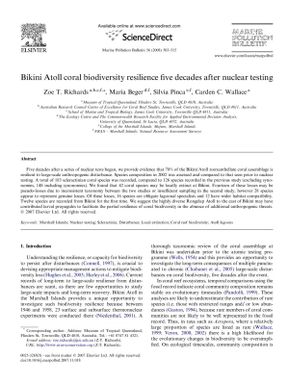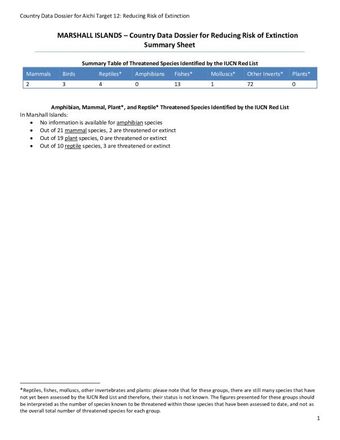Bikini Atoll coral biodiversity resilience five decades after nuclear testing
- Description:
- Five decades after a series of nuclear tests began, we provide evidence that 70% of the Bikini Atoll zooxanthellate coral assemblage is resilient to large-scale anthropogenic disturbance. Species composition in 2002 was assessed and compared to that seen prior to nuclear testing. A total of 183 scleractinian coral species was recorded, compared to 126 species recorded in the previous study (excluding synonomies, 148 including synonomies). We found that 42 coral species may be locally extinct at Bikini. Fourteen of these losses may be pseudo-losses due to inconsistent taxonomy between the two studies or insufficient sampling in the second study, however 28 species appear to represent genuine losses. Of these losses, 16 species are obligate lagoonal specialists and 12 have wider habitat compatibility. Twelve species are recorded from Bikini for the first time. We suggest the highly diverse Rongelap Atoll to the east of Bikini may have contributed larval propagules to facilitate the partial resilience of coral biodiversity in the absence of additional anthropogenic threats.
- Display date:
- 2007
- Collections:
- Secretariat of the Pacific Regional Environment Programme (SPREP)
- Publisher:
- Elsevier Ltd.
- Content partner:
- Secretariat of the Pacific Regional Environment Programme (SPREP)
- Availability:
- Not specified
-
Copyright status: All rights reservedFind out more about what you are able to do with this itemThis item is all rights reserved, with means you'll have to get permission from Secretariat of the Pacific Regional Environment Programme (SPREP) before using it. For more information, please see our use and reuse page.What can I do with this item?Non-infringing useNZ copyright law does not prevent every use of a copyright work, and this item may be hosted by an international institute or organisation. You should consider what you can and cannot do with a copyright work.No sharingYou may not copy and/or share this item with others without further permission. This includes posting it on your blog, using it in a presentation, or any other public use.No modifyingYou are not allowed to adapt or remix this item into any other works.No commercial useYou may not use this item commercially.
Related items
Welcome and warm Pasifik greetings
The information on this site has been gathered from our content partners.
The names, terms, and labels that we present on the site may contain images or voices of deceased persons and may also reflect the bias, norms, and perspective of the period of time in which they were created. We accept that these may not be appropriate today.
If you have any concerns or questions about an item, please contact us.

